Preserving food has been a time-honored practice that dates back to ancient civilizations.
In times when refrigeration and advanced storage techniques were not available, our ancestors relied on various methods to ensure their food lasted longer, reducing waste and ensuring a steady food supply throughout the year.
Even in the modern world, food preservation remains a valuable skill, enabling us to save money, reduce our ecological footprint, and savor the flavors of seasonal produce year-round.
While there are various modern preservation techniques, many pantry items can be used to achieve the same goal, keeping our food fresh and delicious for extended periods.
Food preservation is essential for extending the shelf life of perishable items and reducing food waste.
While many items can be used for food preservation, some commonly used options are listed below.
Salt
Among the oldest and most effective preservation agents, salt helps draw out moisture from foods, inhibiting the growth of bacteria and preventing spoilage. It is widely used for curing meats, preserving fish, and pickling vegetables.
Often referred to as salting, this is one way to preserve foods for an extended period. Salting, like many preserving techniques, changes the flavor. Thus, you will want to rinse salt-preserved foods well before eating.
While you can use salt to preserve almost anything, salted fish is one of my favorite salt-preserving recipes.
Salted Fish
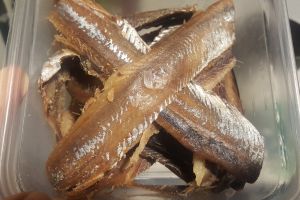 To create salted fish, rinse the fish and pat it dry. Cover the fish with a layer of salt, at least ½ inch thick. You can create layers of fish and salt if you ensure the fish is all covered in a layer of salt at least ½ inch thick.
To create salted fish, rinse the fish and pat it dry. Cover the fish with a layer of salt, at least ½ inch thick. You can create layers of fish and salt if you ensure the fish is all covered in a layer of salt at least ½ inch thick.
Place the salted fish into the fridge or cold cellar for 2 days.
If you don’t have a root cellar, here’s a cheap and easy way to build a root cellar in your backyard.
After 2 days, remove the fish and shake off the excess salt. Wrap the fish in cheesecloth and place it on a rack over a plate to catch any juices. Let the wrapped fish sit in the fridge or cellar for a week.
After the week has passed, remove the cheesecloth and store the fish in a sealed container in a cool spot such as the fridge or cellar.
When you want to eat the fish, soak it in water for 24 hours before cooking, changing the water throughout to remove excessive salt.
Sugar
This staple is more than a sweet treat; it also serves as a vital preservative.
When combined with fruits, sugar helps create delicious jams, jellies, and preserves, extending the shelf life of a product such as fruit that would otherwise spoil quickly.
Sugaring
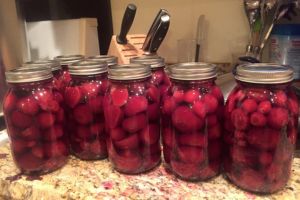 Sugar has been used extensively to preserve fruits such as apples, pears, and berries. When sugar is added to food, it binds to the water and reduces the amount, hindering the growth of bacteria.
Sugar has been used extensively to preserve fruits such as apples, pears, and berries. When sugar is added to food, it binds to the water and reduces the amount, hindering the growth of bacteria.
Although sugar is used in many ways, it is commonly turned into a syrup.
This method is called sugaring, and it is popular because it does not require the use of specialized canning equipment.
Related: How To Make Antiseptic Sugardine To Treat Wounds And Inflammation
An 18th-century recipe for sugaring includes using an equal amount of sugar and fruit.
Mix the sugar (e.g., 2 cups) with ½ cup of water and cook until it fully dissolves and forms a thin syrup. Add fruit to the liquid and let it boil gently for a few minutes or until the fruit is cooked through but not mushy.
Remove the fruit from the liquid and cool both separately. Once cool, add both to a single jar. Seal and store in a cool, dark place.
Vinegar
With its acidic properties, vinegar is an excellent preservative, particularly in pickling. Submerging vegetables and fruits in vinegar solutions inhibits the growth of microorganisms and preserves their texture and taste.
Vinegar pickling is a popular ‘quick pickling’ process. Vinegar has a long history in food preservation and dates back to the ancient Egyptians.
When you preserve vegetables with vinegar, it means that the veggies last a long time. This is important because, generally, fresh produce will spoil quickly.
Quick-Pickling
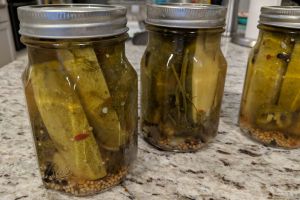 Quick pickling is super easy to do.
Quick pickling is super easy to do.
Start by washing and sanitizing the jars and lids and cutting up the veggies you want to preserve. Add herbs and spices to the jars. Garlic, thyme, and rosemary are all great options, but endless possibilities exist. Next, tightly pack your vegetables into the jars.
Related: How To Pickle Watermelon Rind The Amish Way
In a saucepan, combine 1 cup of white vinegar, 1 cup of water, 1 tbsp. kosher salt, and 1 tbsp. sugar. Dissolve the mixture by boiling over high heat to create a syrup.
Pour the syrup over the vegetables in the jars, leaving a ½ inch headroom. Seal and store.
Oil
Immersing food items in oil creates a barrier that helps prevent spoilage by reducing exposure to air.
This technique is commonly used for preserving herbs, garlic, or other flavorful additions. However, olive oil can also be used to protect vegetables.
Olive Oil Marinade
Marinating vegetables in olive oil is simple and so tasty. This process allows you to enjoy the summer’s bounty throughout the colder months.
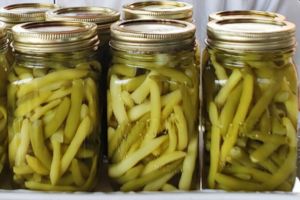 You can easily store any veggie using herbs and olive oil.
You can easily store any veggie using herbs and olive oil.
Peppers, zucchini, beets, or green beans are popular options.
Whatever you choose, the vegetables used in this storage method must be fully cooked and stored in a cool, dark place.
It is also vital to ensure that the olive oil completely covers the vegetables to prevent bacteria growth.
To preserve veggies in olive oil, gather 4 cups of the vegetable to want to store and cook them thoroughly, leaving them slightly crispy.
Use 2 parts olive oil and 1 part vinegar. Season your veggies any way you like. Use garlic, salt, chili peppers, etc.
Generously coat the vegetables in ¼ cup of vinegar and let it sit for 15 minutes. Add ½ cup of olive oil. You can use more or less, but remember to stick to the 2-to-1 scale.
Place the cooked, seasoned veggies into a jar or container and add more of the mixture.
Citric Acid
Essential for canning and pickling, citric acid heightens acidity, which is unfavorable for bacteria and molds, prolonging the shelf life of preserved foods.
Often, recipes call for using lemon juice, but citric acid shines as a substitute. While you will want to research the topic, adding ½ tsp per quart or ¼ tsp per pint is common.
Preserving food using pantry items not only harkens back to our culinary roots but also empowers us with valuable skills for reducing food waste and enhancing sustainability.
These time-tested preservation techniques, passed down through generations, allow us to enjoy the bounty of seasonal produce year-round while minimizing our environmental impact.
From the simplicity of salt and sugar to the tang of vinegar and the natural goodness of honey, these pantry items offer many possibilities to keep our food fresh, flavorful, and ready to savor.
Remember to follow proper food safety guidelines and procedures when using these pantry items for food preservation. Always sanitize jars and containers, and use fresh, high-quality ingredients for the best results.
You may also like:
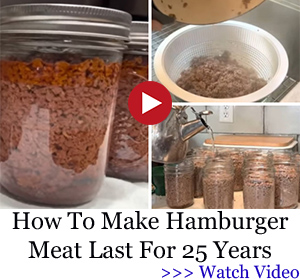 The Best Over The Counter Drugs You Should Hoard
The Best Over The Counter Drugs You Should Hoard
What To Do With All Your Frozen Food Once The Power Goes Out (Video)
16 Wild Edibles You Didn’t Know You Could Forage For

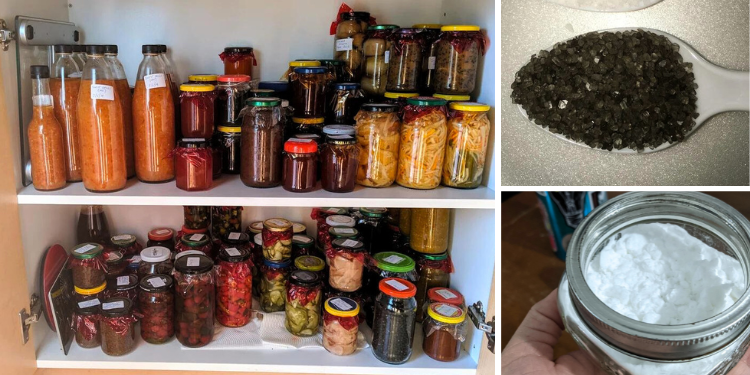




















Ever notice buying bagged salad veggies once opened last a couple of days lately? Is the transportation or storing the product causing the veggies to bad sooner. It seems before the Covid reset food items lasted longer. Can this be part of the food shortage syndrome were in?
The potable water we consume and for irrigated farm crops. How do we know the Municipal water utilities are really being tested for harmful chemicals? Is it necessary to add Floride to the water we drink?
In my area all the fresh vegetables are going going bad 1 to 2 days after getting them home. Part of that is the vegtables are freezing either in the packaging plant or in the truck on the way to market. As far as why the change after COVID I do not know.
I’m thinking that the store is keeping fruits and vegetables on their shelves longer than they used to because the quantities are not as readily available as they once were and are more costly from the shipper so the store doesn’t want to throw them out if they can sell them.
I honestly cannot recall the last time I got good produce shipped here from California. This is not just an anti-California thing. If I see produce labeled from Calf I will likely pass. It’s been like this for several years.
NEVER ADD FLUORIDE!!!! Read up my friend. It is bad for you.
Fluoride saps the bodies vital essence. I only drink rain water and pure distilled grain alcohol.
I use a certified floride filter.
The food is coming from farther, resulting in additional time in delivery.
Also many veggies offgas, and if that gas is not removed it causes spoilage much more quickly.
If you leave the veggies in their plastic bags, of course they’ll go bad quicker.
Throw them in a glass container with a lid that lets those gases exit and you’ll see it last much longer.
Fluoride directly on teeth can help prevent decay but administered systemically (drinking water) has no such effect. It’s an industrial toxic pollutant. Although many municipal water systems are graded as Superior, the data shows otherwise for toxic pollutants. Not sure if reverse osmosis will take them out. Something like a Berkey filter with the additional candles can remove heavy metals, fluoroide, chlorine/chloramine, etc.
Apeel is a relatively new product being applied to product to make it look good longer. IDK about nutritional effects. It is in the major grocers and some products carry the label and some don’t. It does not wash off. FDA says “generally regarded as safe” (GRAS) but long term studies on humans have not been done. IDK if it penetrates the skins but I’m going to peel everything I can. Time to plant salad greens though.
As always, do your own research and draw your own conclusions. My message is just a head’s up.
Preppers who do canning in small batches. Do you find you use the water bath method more than the pressure cooking method? Or does that depend on the food items being canned?
I am new to the canning method to preserve foods. I understand the BALL canning book is the bible for canning. Do preppers use other canning books as a guideline than BALL? Thanks for your help, as I learn canning.
PS, I did get an All American pressure cooker made in the USA. That does not need rubber O-rings as other pressure cookers need to keep a seal.
Was lucky to get the All American from a neighbor. Can’t believe how expensive these pressure cooker are on the websites. Just like having backyard chickens the hen house and a secure chicken pen are probably the most expensive parts. Most premade hen houses are expensive China made cheap wood.
Ended up building my own hen house pre-covid, when wood was still cheap to buy at the big box stores.
Side note,
Funny how the big box stores stayed open during Covid fearmongering. It was they sold China made products. If they closed China could not make profit and build up their military. As America reduced it’s military ready military in all branches.
A friend in the military told me of the goings on there, scary.
Covid killed over 1 million Americans. So stop with the bullshit of “its fear mongering”.
American pressure cookers I believe are made here in Manitowoc WI by Wisconsin Aluminum Foundry (WAF), I have one the foundry made in the 50’s before they made them for American, the machining and quality of the metal make the gaskets/o-rings not needed so you have a quality cooker that’s been a tried and true American made product.
For me it depends on what I’m canning if I use water bath or pressure canner.
I use Presto as my guide.
I inherited my All American canner from my grandmother. It is 75 years old and I use it every summer, they are cheap for a generational tool. And they haven’t changed, new parts still fit the old ones.
Use the Ball canning book and you should be safe. The method used is determined by what the food item is. This is fairly well detailed in that book. DON’T take shortcuts or get “creative” at this point in your journey. There is plenty of time for that later. I’ve been canning and freezing meat and vegetables for over 60 years now. I STILL use the Ball book as my primary guide. Remember to enjoy the journey too! Good Luck!!!
It depends on the food you are canning. Low acid foods need to be pressure canned. DO NOT fudge around on this! Your life may depend on it regarding botulism. Use only safe canning practices. And by all means, have some fun, but you have to follow the guidelines strictly!
Growing and canning your own food by Jackie Clay, one of the best books you can get on canning!
For 50 years, I have only water bath canned.
So, that limits me and I have to use a freezer for lots of foods.
I just canned 12 quarts of tomatoes. They are so pretty and for $1 a quart, that was a good deal.
I missed strawberries because of the weather here; got about 3 dozen ears of corn for boiling in the freezer–have cut off corn still in the freezer.
Peaches, I can’t afford.
The corn was given to me and dozen around here is $6. Nope, not me.
I bartered for green beans and didn’t feel like canning, so in the freezer they went.
God bless and stay safe canning those foods….Good luck.
Gerrymandering, I am also fairly new to canning. I use an Amish canning book, also have Ball Canning, but I use info from the Canning Rebels website. You can ask any question & receive answers quickly. It also has a file that people contribute that is priceless. The administrator does not put up with BS or criticism. Ummm. You do have to put up with bad language used. It is allowed.
There isn’t really a “choice” about which method to use for canning, as they are used for different reasons — water bath canning is for high-acid foods, pressure canning is for low-acid foods.
Yes I was too young when my Mom did pressure canning to learn. I too have to self learn. The neighbors around me don’t do canning. A few did but are older and arthritic to can anymore.
It is one of those dying arts in parts of this country. A valuable skill needed in these chaotic Biden times.
Paul, ask your old, arthritic neighbors to supervise you canning. They may not be able to chop much produce or lift a loaded canner, but they can tell you when the boil is enough to start timing your water bath processing, of when the pressure is right to stsrt the pressure canning time.
Yes, some PCs come with gauges and others with weights only, but it’s helpful to have someone who knows how with you. I didn’t have that luxury. I now do have some canning buddies, and it’s more enjoyable. When I was teaching a friend who wanted to learn how to pressure can, I could show her how to look for the plume of steam to start the ten-minure vent, and when the weight .iced enough to start the timing.
Different makes of PCs will have the weights move a little differently when it’s considered right for processing time. Some wild spin around faster, some are right when they spin a few times a minute, and others rock back and forth.
This is where having a gauge can be helpful, do long as you know the gauge is correct.
And, you’ll also need to know your elevation to know which hos much weight to use/psi needed on the gauge, or if water-bath canning, how much extra time to add, since most recipes provide times only for those at sea level or below 1000 or 2000 ft.
Again, that’s stuff your elderly neighbors would likely know. You can give them some of your finished product in exchange for their knowledge.
A comment farther up asked about good books to get for canning. The Ball Blue book is great to have. I also have jam recipes, chutneys, and various pickle recipes in cookbooks (most older).
I have a presto canner and a mirro canner. The presto manual is really excellent, not only for instructions on how to use the canner, but also for processing times for all kinds of fruit and veg as well as meats. I’ve never seen an All-American canner’s manual to know how helpful it is.
The Complete Guide to Pressure Canning by Diane Devereaux aka the Canning Diva is helpful if you want to make some meals in a jar, rather than can items separately. She provides a chapter on different soups to can,, too, which is helpful.
There is a website https://nchfp.uga.edu that has lots of info on how to can and preserve food. If you search for nchfp, you can get a link to the website, in case the one I copied doesn’t work for some reason.
The NCHFP follows USD Guidelines. I say that, so you know they won’t have information on how to can dairy products. Some people have done this successfully home, and others,when they hear about it, develop a nervous tic.
Some of the recommendations have changed over the years. Older people who have been canning before the Internet may not check in with NCHFP, especially if they typically can the same items every year.
Starting out, I think it best to follow a reputable source such as NCHFP, so you can be sure to get the basics down, especially if you are on your own doing this. But, if your elderly neighbor still uses paraffin to cover her jellies in jelly jars for which no two piece lids exist, I think that also a great skill to acquire.
To frequently, even those with livestock do not consider how important having adequate storage of salt and mineral would be. Here we keep plastic 55 gallon barrels filled with loose salt and mineral for livestock. As an example, inadequate levels of mineral/trace minerals cattle will not cycle correctly. These barrels are kept in the secure and rodent proof feed room with all the bulk livestock grains. We further keep bulk storage of all the above items in the store room of the house for us. If you have, or are going to have livestock [especially cattle, hogs, sheep, goats] you must provide for them as well.
Food preservation or longevity after bought……..I have only seen a problem once although I don’t buy like I used to.
I got 4 tomatoes and came home and used one/the next morning, I found the other 3 on the buffet rotted, actually with green mold all over the fruit. Not just in spots, the fruit was covered with mold.
My first reaction was, I ate one the previous night.
Back in the day it was a way of life to can, preserve and grow your own food. Now the right thinks its “end of times, rapture bullsh*t”.
Well for the Demoncrats. Relying on their incompetent liberal Hawaiian government response in Maui it is the end of times there. When was there emergency alert system tested. And don’t they have different alarm sounds for each disaster? Like tsunami, fires and so on. Their excuse sounding the alarm would signal a tsunami then a fire. Everyone would go up the hills where the fire would follow them.
Something taint right about the whole situation in Maui.
Maybe Lisa can go there and help out the island people. We are too old to help physically, we donated to help them.
What have you done to help Maui while Biden sends billions to Ukraine?
In relation to the article; no matter what we prep for as far as food here.
We must also take care of our choppers for eating. Recently since not seeing my dentist during Covid. I finally saw a new dentist, my old one retired.
I could not believe the high cost needed for the dental work. I need to find a good dental insurance plan that does not need a second mortgage on the house to use. Previously when working I could afford the dental treatment. Now retired, see dental issues could be a serious problem in a SHTF or bugging out to the countryside.
Just saying prepping isn’t just about food, shelter and clothing. Our health is just as important to keep us going in a crisis.
Which comes to mind in a SHTF, we maybe prepared with food and shelter. But things like dental is not something preppers are skilled at. So health also effects our preps in cooking and being able to eat the meal with no pain.
I am using AMAC to buy my dental. Seems to be a lot cheaper than other plans.
Lisa Blake,
You need to fact check your numbers and not listen to the news. The CDC and Statista show graphs and data. (If you choose to believe them) The total number of deaths increased 530,000 from 2019 to 2020 if you subtract the 44,000 deaths average year over year since 1990 the total number of deaths attributed to covid 19 is 486,000 in 2020. You may add approximately another 50,000 for 2021. This number is unaceptable but it is not over 1 million. I have sympathy for everyone who lost someone. Covid should never have happened and You must place the blame squarely on the CDC and Anthony Fauci for authorizing it and paying for it. If the CDC was directed to do the research for Gain of function by some other government agency they are also complicit. There needs to be serious jail time for the lot of decision makers. Why is the collateral damage always to the innocent people.
Went to dentist and received the billing for it. Billed for fluoride treatment. Insurance denied because patient was over age of 19. When office contacted, told that the fluoride is in the cleaning paste. And, that there was no other option when having a cleaning. No opt out option. Anyone else aware they were doing this?
You mentioned sugar as a preservative. I was wondering could you use maple syrup or honey as well. If you thinned them out with water or did not boil the sap down as far would that work? You mentioned the sugar for veggies, could you also use it for meat? I could see a piece of steae in maple syrup for the flavoring.
And yet again Lisa is quoting MSM. Perhaps over a million people died with Covid but we have now idea how many actually died from covid… yeah there is a difference. Try a little research Lisa and turn of MSNBC.